

When School Leaders Empower Teachers, Better Ideas Emerge. Teachers are increasingly being pushed into new roles as their ability to connect online opens up new opportunities.
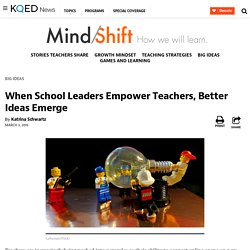
Educators are finding their own professional development, sharing lesson plans and teaching tips with colleagues around the world, and have often become ambassadors to the public on new approaches to teaching and learning. Easy access to information has empowered many educators to think and teach differently, but often those innovations remain isolated inside classrooms.
Without a school leader who trusts his or her teachers, it is difficult to convert pockets of innovation into a school culture of empowered teachers. One way of building that kind of unified school culture is through distributed leadership, the idea that no one person at the top of the hierarchy makes all the decisions that will affect the work lives of the adults in the building. “Teachers have to really own what they are in charge of,” said Aaron Gerwer, intern principal at SLA. Educational Leadership:Teachers as Leaders:Ten Roles for Teacher Leaders. Educational Leadership:Teachers as Leaders:The Many Faces of Leadership. Educational Leadership:Beyond Instructional Leadership:A Framework for Shared Leadership. How to get an irrational person to make sense. The first thing you need to do to get an irrational person to behave rationally is to calm yourself down so that you don’t escalate the situation with your own irrational and emotional reaction.

If you’re viewing a person as irrational, it means they’ve already succeeded in getting you upset enough to take something they’re doing or saying too personally when you shouldn’t. When that happens, a part of your middle emotional brain called the amygdala will hijack you away from thinking rationally and responding accordingly. It does so by blocking you from accessing your upper rational brain to evaluate the situation. Thinking of someone as irrational can mean you’re feeling as if they are intentionally acting in some way just to get you upset — and then you react by becoming upset. Alternatively, if you view them as merely not rational, and don’t take their behavior personally, you will be able to take your emotionality out of the equation. Teacherpreneur trade secrets: 5 ways all teachers can advocate for the profession SmartBlogs. Welcome to SmartBrief Education’s original content series about the unique stories of teacherpreneurs.

These are the innovative individuals confronting challenges, creating solutions and challenging the traditional definition of “educator.” For teachers, the politics surrounding public education sometimes makes it feel more like 1773 than 2015. ASCD Book: Peer Coaching to Enrich Professional Practice, School Culture, and Student Learning. Pam Robbins Table of Contents Video | About the Author | Comments How can educators work together more effectively to improve professional practice in a way that enhances student performance?

The answer, says author Pam Robbins, involves combining collaborative activities and peer coaching—teachers supporting teachers. This book describes how any school can implement these proven practices and experience positive changes in teaching, school culture, and learning. Teachers as leaders: Building capacity to serve ELs SmartBlogs. SmartBlog on Education will highlight summer learning and enrichment for educators during June.

In this blog post, advocate and author Ayanna Cooper explores professional development models for teachers of English learners. In an effort to improve outcomes for students identified as English learners (ELs) a number of initiatives, program models, standards and assessments, model curriculum units, etc., have been created, spearheaded, implemented and evaluated. Despite all of this, in some places, a complex step has been inadvertently missed: supporting teachers of ELs as leaders. 5 Communication Tips For Educators. If education is viewed as a relationship with students, families, and the community, then good communication should be a priority.
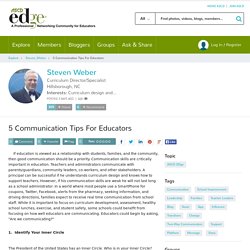
Communication skills are critically important in education. Teachers and administrators communicate with parents/guardians, community leaders, co-workers, and other stakeholders. A principal can be successful if he understands curriculum design and knows how to support teachers. However, if his communication skills are weak he will not last long as a school administrator. In a world where most people use a SmartPhone for coupons, Twitter, Facebook, alerts from the pharmacy, seeking information, and driving directions, families expect to receive real time communication from school staff. Professional learning that connects, empowers teachers SmartBlogs. As educators, our core business is learning.
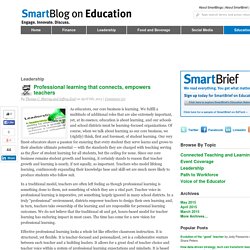
We fulfill a multitude of additional roles that are also extremely important, yet, at its essence, education is about learning, and our schools and school districts must be learning-focused organizations. Of course, when we talk about learning as our core business, we (rightly) think, first and foremost, of student learning. Our very finest educators share a passion for ensuring that every student they serve learns and grows to their absolute ultimate potential — with the standards they are charged with teaching serving as the floor of student learning for all students, but the ceiling for none.
When School Leaders Empower Teachers, Better Ideas Emerge. EdChange - Multicultural & Diversity Consulting for Equity and Social Justice. ASSOCIATION FOR SUPERVISION AND CURRICULUM DEVELOPMENT WebEx Enterprise Site. Out with professional development, in with professional learning. As a classroom teacher I engaged in several years of “professional development” before transitioning to a role of technology specialist, my first opportunity to design and facilitate learning sessions for my colleagues.
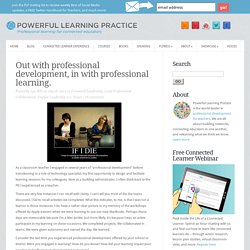
Now as a building administrator, I often think back to the PD I experienced as a teacher. There are very few instances I can recall with clarity. I can’t tell you most of the the topics discussed. I fail to recall activities we completed. Professional Development vs. Professional Learning. I originally wrote this as a reflection for a doctoral course I am taking in Professional Learning for Educators.
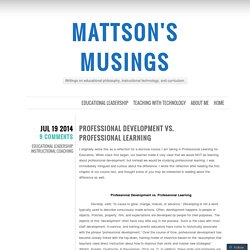
When class first began, our teacher made it very clear that we would NOT be learning about professional development, but instead we would be studying professional learning. I was immediately intrigued and curious about the difference. I wrote this reflection after reading the first chapter of our course text, and thought some of you may be interested in reading about the difference as well. Professional Development vs. Professional Learning. Adjusting Course. Image Credit: eden-saga.com Professional Development (PD) is one of the most important undertakings a school leader can invest in.
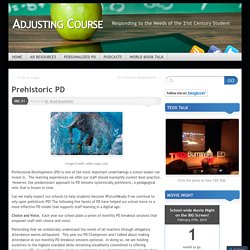
The learning experiences we offer our staff should exemplify current-best-practice. However, the predominant approach to PD remains systemically prehistoric; a pedagogical relic that is frozen in time. Can we really expect our schools to help students become #FutureReady if we continue to rely upon prehistoric PD? The following five facets of PD have helped our school move to a more effective PD model that supports staff learning in a digital age: How to Create a Positive School Climate. If you’re a school leader, you have problems to solve: bullying, teacher burnout, disengaged students, casual vandalism and litter, and cultural and socio-economic differences, among others. Big issues that affect a lot of people. asiseeit Researchers have found that a positive school climate can help solve a lot of those problems.
Studies find that it decreases absenteeism, suspensions, substance abuse, and bullying, and increases students’ academic achievement, motivation to learn, and psychological well-being. Tough Conversations. A teacher who has known me for many years, knows that I appreciate my job because of the energy I receive every day from teachers and students.
Yes, Sunday night is not always easy on the soul but once I’m in the building on Monday morning, all is well. I avoid my office as much as possible during school time and work the job in classrooms and hallways. It doesn’t hurt my allegiance to the job that many members of our staff have been together for years and those that have been recently hired have melded in nicely with the family. Leadership Tools. Digital Leadership: Changing Paradigms for Changing Times.